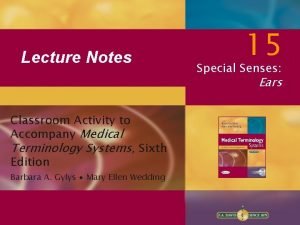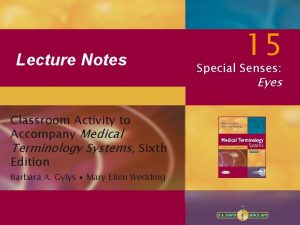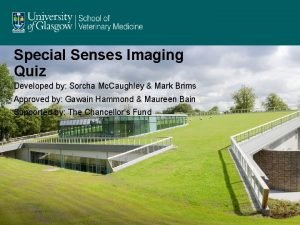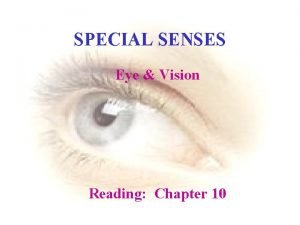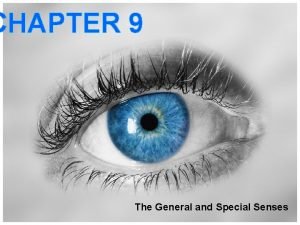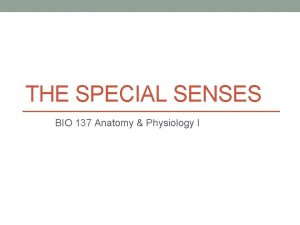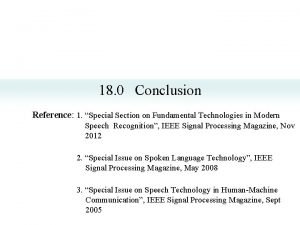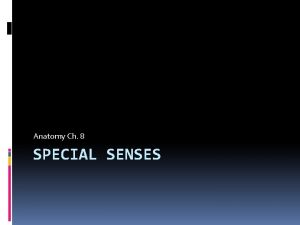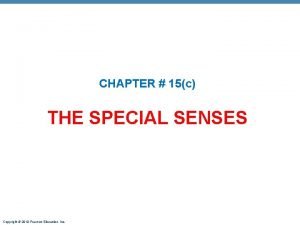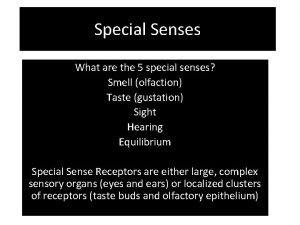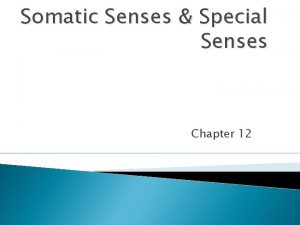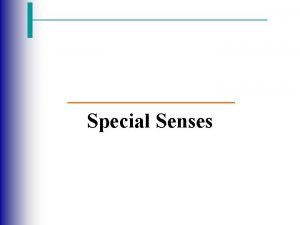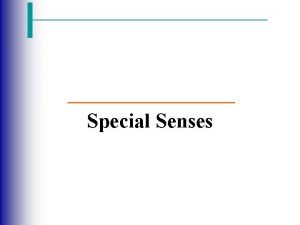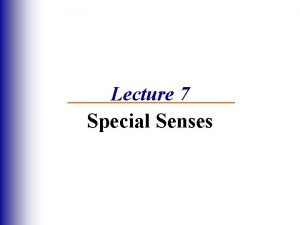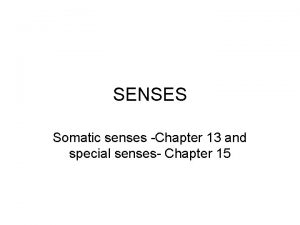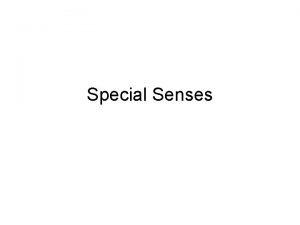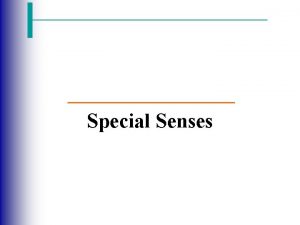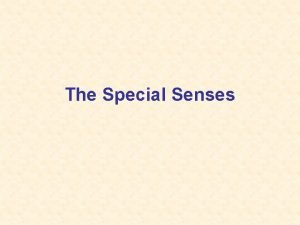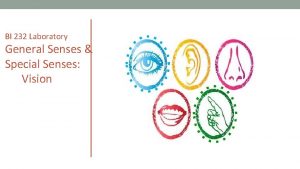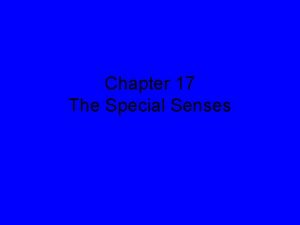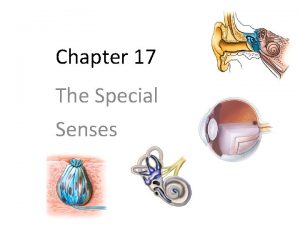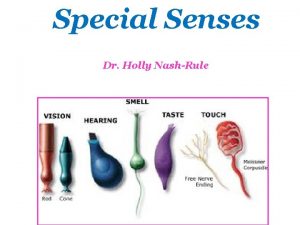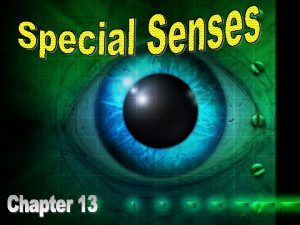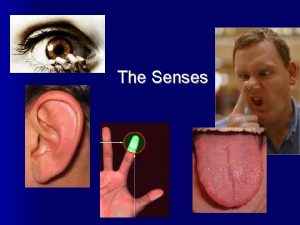The Special Senses Vision 2 Professor A M

























































- Slides: 57



The Special Senses Vision - 2 Professor A. M. A Abdel Gader MD, Ph. D, FRCP (London & Edinburgh), FRSH (London) Professor of Physiology, College of Medicine & King Khalid University Hospital Riyadh, Saudi Arabia

The Physiology of Vision Objectives: At the end of this lecture the student should be able to: • Understand the optical bases of image formation on the retina • Understand explain the optical bases of common refractive errors • Understand the electrical bases of the photoreceptor function • Understand the nature and function visual pigments Understand color vision

The Physiology of Vision Objectives: At the end of this lecture the student should be able to: • Understand the optical bases of image formation on the retina • Understand explain the optical bases of common refractive errors • Understand the electrical bases of the photoreceptor function • Understand the nature and function visual pigments Understand color vision

Physiology of Vision Light Receptor: Retina (Photoreceptors) • Stimulus: •

Light • Definition: ‘elctromagnetic’ radiation that is capable of exciting the human eye’ • Extremely fast

Which travels faster: light or sound?

Electromagnetic spectrum & The visible light spectrum

The Electromagnetic Spectrum

Visible light & Duplicity Theory of vision Visible light Spectrum • Extends from 397 to 723 nm • Eye functions under two 2 conditions of illumination: – Bright light (Photopic vision)…Cones – Dim light (Scotopic vision). . Rods Duplicity theory of vision

Duplicity theory • Photopic visibilty curve peaks at 505 nm • Scotopic “” ” “ “ 550 nm








Photoreceptors Rods & Cones Morphology & Distribution

Retina Back of retina, pigment epithelium (Choroid) Light

Rods and Cones Figure 17. 13


Photoreceptors Figure 16. 11

Retina: distribution photoreceptors

Receptor density (cells x 103 / mm 2) Distribution of photoreceptors

Normal Fundus Photoreceptors are not distributed uniformly across the retina Optic disc Macula 5000 um 650, 000 cones Fovea 1500 um 100, 000 cones Foveola 350 um 25, 000 cones

Human foveal pit INL Light ONL Foveola

Low Convergence Cone-Fed Circuits Retinal ganglion cell Bipolar cell Cone High Convergence Rod-Fed Circuits Retina ganglion cell Bipolar cell Rod Convergence rod/cone cells

Retina: photoreceptors • 100, 000 rods • 5, 000 cones Cones Fovea High light levels Color Good acuity Rods Periphery Low light levels Monochromatic Poor acuity

Electrophysiology of Vision Genesis of electrical responses

Retinal photoreceptors mechanism Light Absorption by photosensitive substances Structural change in photosensitive substances Phototransduction Action potential in the optic nerve

Action Potential Propagated and “All-or-None” Receptor Potential Local & Graded

Retina: Neural Circuitry Light hits photoreceptors, sends signal to the bipolar cells Bipolar cells send signal to ganglion cells Ganglion cells send signal to the brain

In Darkness

Photoreception-cont.

Retina Light

Electrophysiology of Vision Electric recording in Retinal cells: • Rods & Cones: Hyperpolarization • Bipolar cells: Hyper- & Depolarization • Horizental cells: Hyperpolarization • Amacrine cells: Depolarizing potential • Ganglion cells: Depolarizing potential

outer segment Disk membrane Intracellular disk Intracellular space Disk membrane Extracellular space Visual pigment Extracellular space Intracellular space Visual pigment Plasma membrane Connecting cilium ROD CELL CONE CELL Rods and Cones

Rods Light Environment Dim light - scotopic Bright light - photopic Spectral sensitivity 1 pigment 3 pigments Color discrimination No Yes Absolute sensitivity High Low Speed of response Slow Fast Rate of dark adaptation Fast Slow Starlight Moonlight No color vision Poor acuity Scotopic Absolute threshold Cones Indoor lighting Good color vision Best acuity Mesopic Cone threshold Sunlight Photopic Rod Saturation begins Best acuity Indirect Ophthalmoscope Damage Possible Comparison Scotopic and Photopic systems

Photoreceptor pigments

Photoreceptor pigments • Composition: – Retinine 1 (Aldehyde of vitamin A) • Same in all pigments – Opsin (protein) • Different amino acid sequence in different pigments Rhodopsin (Rod pigment): Retinine + scotopsin

Photoreceptor compounds -cont Rhodopsin (visual purple, scotopsin): Activation of rhodopsin: • In the dark: retinine 1 in the 11 -cis configuration Light All-trans isomer Metarhodopsin II Closure of Na channels

Visual cycle Rhodopsin Light Prelumirhdopsin Inermediates including Metarhodopsin II Vitamin A + Scotopsin Retinine & Scotopsin

Light Change in photopigment Metarhodopsin II Activation of transducin Activation of phophodiesterase Decrease IC cyclic GMP Closure of Na channels Hyperpolarization of receptor Decrease release of synaptic tramitter Action potential in optic nerve fibres

From light reception to receptor potential

Retina: Neural Circuitry Light hits photoreceptor s, sends signal to the bipolar cells Bipolar cells send signal to ganglion cells Ganglion cells send signal to the brain

Photoreception

Photoreception- cont.

Retina • 100, 000 rods • 5, 000 cones • 1, 000 ganglion cells Convergence

Convergence Cones • Photoreceptors • Ganglion cells Rods

Convergence and Ganglion Cell Function Figure 17. 18

Dark adaptation

Dark adaptation: Increased sensitivity of the photoreceptors when vision shifts from bright to dim light

Dark adaptation • Reaches max in 20 minutes • First 5 minutes …… threshold of cones • 5 to 20 mins ……. Sensitvity of rods Mechanism of dark adaptation: Regeneration of rhodopsin


Dark adaptation-cont. In vitamin A deficiency What happens to Dark adaptation? Night blindness (Nyctalopia)
 Distinguish between general senses and special senses.
Distinguish between general senses and special senses. Special vs general senses
Special vs general senses Building vocabulary activity: the special senses
Building vocabulary activity: the special senses Building vocabulary activity: the special senses
Building vocabulary activity: the special senses Chapter 17 special senses answer key
Chapter 17 special senses answer key Somatic senses
Somatic senses Special senses quiz
Special senses quiz Chapter 15 special senses
Chapter 15 special senses Special senses physiology
Special senses physiology Houses the receptors for hearing
Houses the receptors for hearing Chapter 11 labeling exercises
Chapter 11 labeling exercises Special senses the eyes and ears
Special senses the eyes and ears Palpebral fissure
Palpebral fissure Thermoreceptors
Thermoreceptors Emmentropia
Emmentropia Anatomy and physiology chapter 8 special senses
Anatomy and physiology chapter 8 special senses The general and special senses chapter 9
The general and special senses chapter 9 Special senses physiology
Special senses physiology Conclusion of special senses
Conclusion of special senses Cranial nerves special senses
Cranial nerves special senses The general senses
The general senses Cranucle
Cranucle Pearson
Pearson Five special senses
Five special senses Promotion from assistant to associate professor
Promotion from assistant to associate professor Structured light
Structured light đại từ thay thế
đại từ thay thế Quá trình desamine hóa có thể tạo ra
Quá trình desamine hóa có thể tạo ra Vẽ hình chiếu vuông góc của vật thể sau
Vẽ hình chiếu vuông góc của vật thể sau Công của trọng lực
Công của trọng lực Hát kết hợp bộ gõ cơ thể
Hát kết hợp bộ gõ cơ thể Thế nào là mạng điện lắp đặt kiểu nổi
Thế nào là mạng điện lắp đặt kiểu nổi Dạng đột biến một nhiễm là
Dạng đột biến một nhiễm là Lời thề hippocrates
Lời thề hippocrates Vẽ hình chiếu đứng bằng cạnh của vật thể
Vẽ hình chiếu đứng bằng cạnh của vật thể Phản ứng thế ankan
Phản ứng thế ankan Các môn thể thao bắt đầu bằng tiếng đua
Các môn thể thao bắt đầu bằng tiếng đua Khi nào hổ con có thể sống độc lập
Khi nào hổ con có thể sống độc lập điện thế nghỉ
điện thế nghỉ Một số thể thơ truyền thống
Một số thể thơ truyền thống Thế nào là sự mỏi cơ
Thế nào là sự mỏi cơ Trời xanh đây là của chúng ta thể thơ
Trời xanh đây là của chúng ta thể thơ Lp html
Lp html Voi kéo gỗ như thế nào
Voi kéo gỗ như thế nào Số nguyên là gì
Số nguyên là gì Thiếu nhi thế giới liên hoan
Thiếu nhi thế giới liên hoan Tia chieu sa te
Tia chieu sa te Các châu lục và đại dương trên thế giới
Các châu lục và đại dương trên thế giới Thế nào là hệ số cao nhất
Thế nào là hệ số cao nhất Hệ hô hấp
Hệ hô hấp Tư thế ngồi viết
Tư thế ngồi viết đặc điểm cơ thể của người tối cổ
đặc điểm cơ thể của người tối cổ Mật thư anh em như thể tay chân
Mật thư anh em như thể tay chân Bổ thể
Bổ thể Chụp phim tư thế worms-breton
Chụp phim tư thế worms-breton ưu thế lai là gì
ưu thế lai là gì Tư thế ngồi viết
Tư thế ngồi viết Thẻ vin
Thẻ vin


